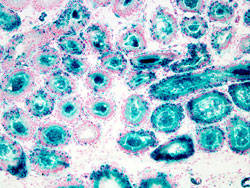
Looking for Cre-, fluorescent protein-, FLP-FRT-, TET-, or lacZ-expressing mouse strains for your neurobiology research? Check out the Research Tools section of the JAX® Mice Database. The diversity, utility and neurobiology-specific selection of JAX® Mice Research Tool strains you'll find there are unmatched — and the collection is rapidly expanding. Furthermore, JAX has implemented a variety of web-based browsing tools that make finding the research tool strains you need quicker and easier.
Below is a brief summary of these available and upcoming resources.
Cre-expressing strains
The JAX® Repository distributes a vast list of Cre-expressing strains appropriate for neurobiology research. These encompass three broad categories:
- Strains in which Cre recombinase is controlled by either nerve tissue-specific or widely expressed promoters (to produce either tissue specific or general knockouts)
- Strains in which Cre recombinase can be turned on or off in specific parts of the nervous system by administering or withdrawing certain chemicals in the diet (to create inducible knockouts)
- Strains in which the location of Cre recombinase activity in the nervous system can be traced by visualizing co-expressed fluorescent proteins
The Repository also distributes strains designed to be reporters of Cre activity and a large number of mice carrying floxed alleles (loxP strains) relevant to neurobiology.
Site of expression tables
At the cre website you can view a list of Cre-expressing strains by promoter. This feature allows you to see the site(s) of Cre expression in a mouse model's nervous system. At the same website, you can also view cre-expressing strains by stock number, strain name and availability level.
KOMP
The Knockout Mouse Project (KOMP) is making scores of loxP conditional strains ("floxed" strains) available to the biomedical research community. To maximize the discovery potential of these strains, researchers will need a diversity of readily available Cre-expressing strains. Given the large number of genes expressed in the brain, the availability of such strains will be particularly important to the neuroscience community. Anticipating this need, JAX will soon be offering the following resources:
NIH Blueprint for neuroscience cre-driver mice
The NIH Blueprint for Neuroscience Research has funded the development of hundreds of well-characterized and brain-specific Cre-expressing mouse strains on a C57BL/6J background (see the following two websites: neuroscienceblueprint and credrivermice). Approximately 100 of these strains will be distributed through JAX.
Allen Institute for Brain Science cre-driver mice
The Allen Institute for Brain Science (AIBS) is generating hundreds of strains in which Cre expression will be controlled by specific cortical cell promoters (mouse/brain map). About 100 of these strains will be available from JAX.
Characterization of brain Cre activity
The AIBS has also developed a high-throughput platform (similar to the Allen Brain Atlas) of in situ reporter gene assays for assessing Cre activity in serial brain sections of the adult mouse. All of the brain-specific Cre-expressing lines that JAX distributes or will distribute, including those coming from the NIH Blueprint Project and those developed at the AIBS, will be assayed, producing a comprehensive data set generated with a common protocol.
Non-neuronal Cre characterization
The Jackson Laboratory Genetic Resource Science group is comprehensively characterizing developmental and non-neuronal Cre activity in Cre-expressing JAX® Mice strains. This includes monitoring Cre reporter activity at several developmental time points in a wide array of tissue types, validating the deletion of an independent conditional allele, and evaluating potential Cre-related toxicity. The resulting data will either supplement or validate published expression patterns, thereby providing essential quality control.
Cre expression database
To facilitate identifying the appropriate Cre-expressing strains for your research, JAX Repository and Mouse Genome Informatics staff have developed a Cre expression database released in 2009. The web interface will allow you to use terms from the hierarchical Mouse Anatomical Dictionary to search for strains by site of Cre expression and will provide links to phenotypic characteristics of mice produced by mating Cre-expressing lines to strains with floxed alleles.
The database includes information from the published literature, the AIBS and NIH Blueprint projects described above, JAX data characterizing developmental stage and non-neuronal Cre expression, and (when available) unpublished data from donating investigators.
Neuronal reporter strains
Reporter genes, such as those encoding lacZ or green, yellow and red fluorescent proteins (GFP, YFP, and RFP), allow researchers to examine the timing and location of gene expression within a tissue, embryo or adult. JAX distributes numerous reporter strains, including the Brainbow mice, a set of increasingly popular and powerful tools for identifying the cells involved in the brain's neural circuitry.
JAX now distributes channelrhodopsin transgenic strains, such as B6.Cg-Tg(Thy1-COP4/EYFP)18Gfng/J (007612) and B6.Cg-Tg(Thy1-COP4/EYFP)9Gfng/J (007615). Both strains express the light-activated ion channel, channelrhodopsin-2 (from the green alga Chlamydomonas reinhardtii), fused to YFP and controlled by the mouse thymus cell antigen 1 (Thy1) promoter. Each expresses the transgene in a unique subset of brain neurons and may be used to map neural circuitry ex vivo and in vivo.
JAX also distributes over 160 JAX® Mice strains incorporating the lacZ reporter system, a reporter system in which a blue dye indicates gene expression. Many of these strains may be used in neurobiology research.
As with Cre-expressing strains, sites of expression for JAX® Mice fluorescent protein-expressing strains are available from our research tools web page.
The Jackson Laboratory's growing collection of research tool strains and resources is sure to advance neurobiology research forward.
References
Dymecki SM, Kim JC. 2007. Molecular neuroanatomy's "Three Gs": a primer. Neuron 54:17-34.
Gavériaux-Ruff C, Kieffer BL. 2007. Conditional gene targeting in the mouse nervous system: Insights into brain function and diseases. Pharmacol Ther Pharmacol Ther 113:619-34.